
Hound-handle pitcher, Harker, Taylor & Co. East Liverpool, Ohio, 1847–1851. Rockingham glazed earthenware. H. 9 3/4". (All objects from the Arthur F. Goldberg collection; photos, Gavin Ashworth).
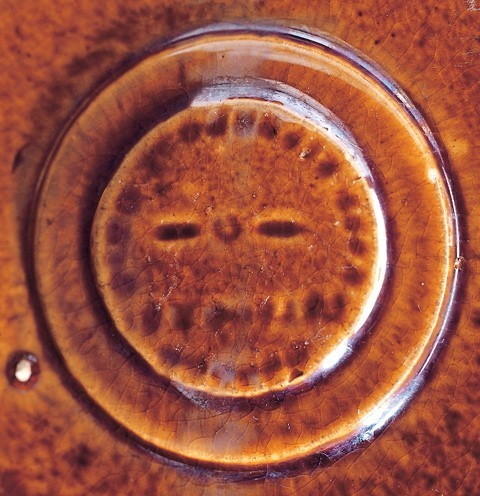
Detail of the Harker, Taylor & Co. mark on the bottom of the pitcher illustrated in fig. 1.
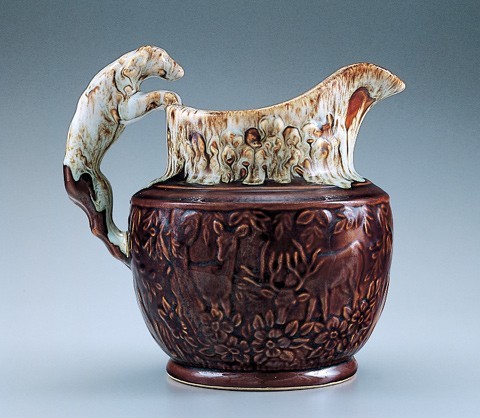
Hound-handle pitcher, East Liverpool, Ohio, ca. 1965. Rockingham glazed earthenware. H. 9 3/4". The upper portion and hound are covered with an off-white glaze. The impressed mark reads: “Reproduction Harker Rockingham/Mfg 1848/U.S.A. 1965.”
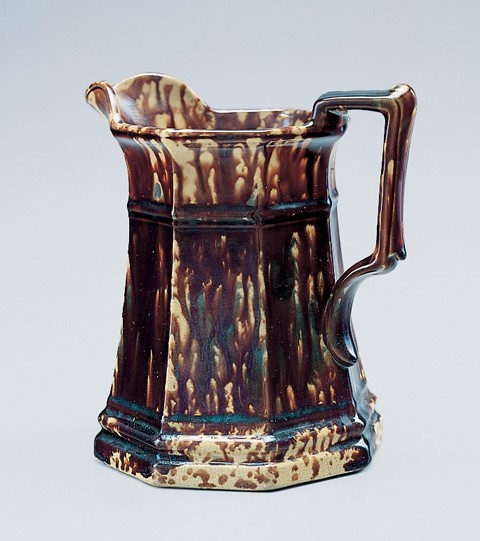
Octagonal paneled pitcher, attributed to Bennett & Brothers, East Liverpool, Ohio, or Pittsburgh, Pennsylvania, ca. 1844. Rockingham glazed earthenware. H. 7 3/8". Powdered flint was added to the Rockingham glaze to produce the streaks of green and blue. A similar pitcher with a different Rockingham glaze is in the collection of the East Liverpool Museum of Ceramics, East Liverpool, Ohio.
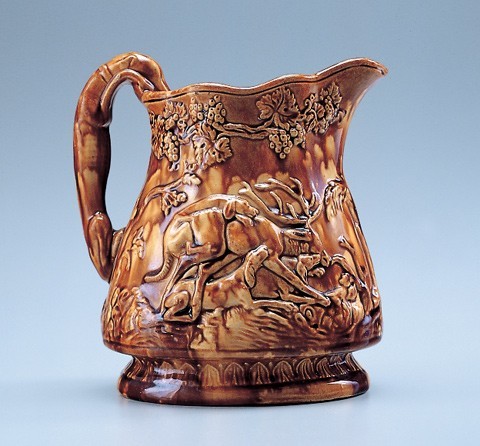
“Boar and Stag Hunt” pitcher with hound handle, E. & W. Bennett, Baltimore, Maryland, 1850–1858. Rockingham glazed earthenware. H. 7 7/8".

“Boar and Stag Hunt” pitcher with hound handle, E. & W. Bennett, Baltimore, Maryland, 1850–1858. Rockingham glazed earthenware. H. 7 7/8".
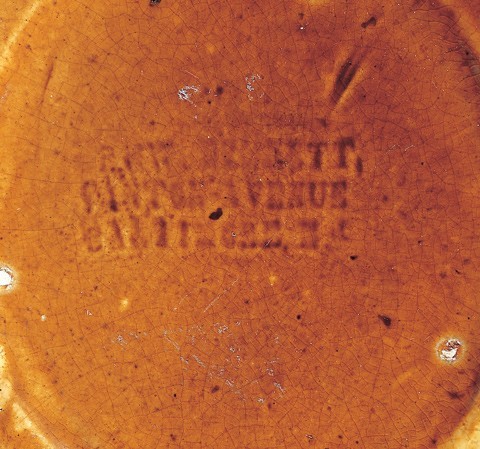
Detail of the mark “E. & W. BENNETT/ CANTON AVENUE/ BALTIMORE, MD”. in large rectangle on the base of the pitcher illustrated in fig. 5. Two of the three stilt marks are visible.

“Gypsy” pitcher, E. & W. Bennett, Baltimore, Maryland, 1850–1858. Rockingham glazed earthenware. H. 8 5/8". This pitcher has a modified branch handle with very crisp defined details. It is marked “E. & W. BENNETT/CANTON AVENUE/BALTIMORE, Md.” in small rectangle and has three stilt marks in a triangular pattern on the base.

“Gypsy” pitcher, E. & W. Bennett, Baltimore, Maryland, 1850–1858. Rockingham glazed earthenware. H. 8 5/8". This pitcher has a modified branch handle with very crisp defined details. It is marked “E. & W. BENNETT/CANTON AVENUE/BALTIMORE, Md.” in small rectangle and has three stilt marks in a triangular pattern on the base.
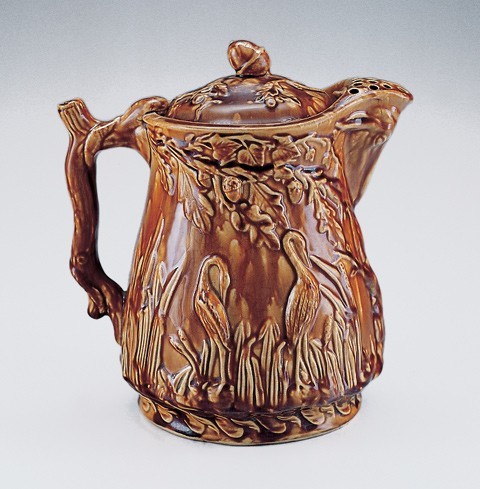
“Heron” pitcher, attributed to E. & W. Bennett, Baltimore, Maryland, 1850–1858. Rockingham glazed earthenware. H. 10". This is a molded covered ale pitcher with a branch handle.
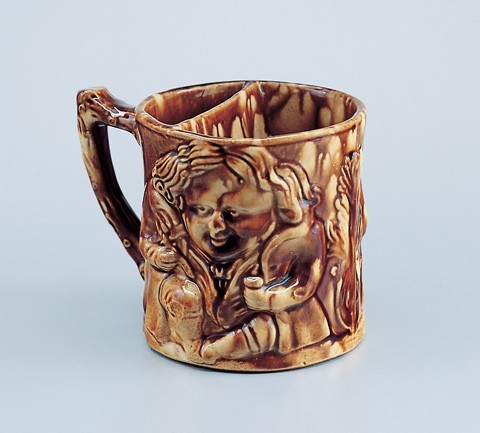
Shaving mug, E. & W. Bennett, Baltimore, Maryland, 1850–1858. Rockingham glazed earthenware. H. 4 3/8". This molded mug has the image on both sides of Toby seated holding a razor in one hand with a mug in his other. It is marked “E. & W. BENNETT/CANTON AVENUE/BALTIMORE/ Md.” and has three stilt marks in a triangular pattern on the base.
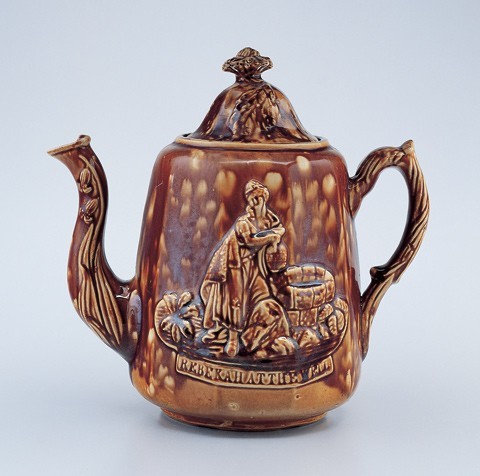
Teapot, attributed to E. & W. Bennett, Baltimore, Maryland 1851–1857. Rockingham glazed earthenware. H. 10". This teapot has the molded inscription “REBEKAH AT THE WELL” on the front and a flower finial on the lid. Three spur marks in a triangular pattern are on the base.
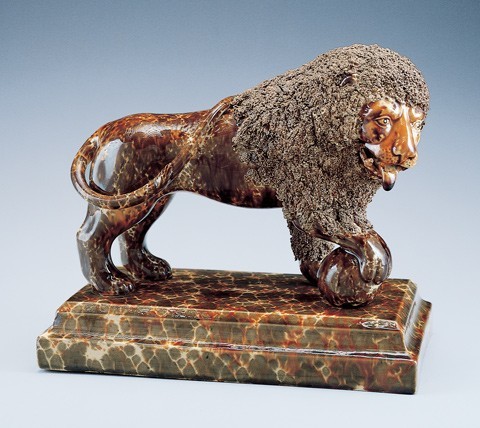
Lion figure, attributed to Lyman, Fenton & Co., or United States Pottery Company, Bennington, Vermont, 1849–1858. Flint enamel earthenware. H. 9 1/2". The lion has a shredded clay mane and a protruding tongue.

Hound-handled pitcher, United States Pottery Company, Bennington, Vermont, 1852–1856. Rockingham glazed earthenware. H. 12 1/8". There are three stilt marks in a triangular pattern on the base.
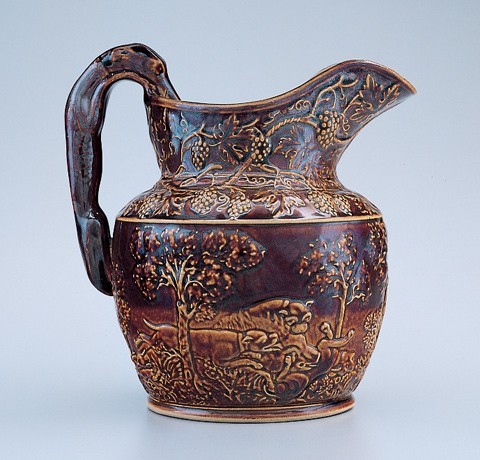
Hound-handle pitcher, American Pottery Company, Jersey City, New Jersey, 1840–1845. Rockingham glazed stoneware. H. 9 1/4". This molded pitcher has double dipped brown glaze on its upper portion and a putty colored glaze inside. The neck and shoulder have an undulating vine with leaves, tendrils, and grape clusters. A scene of hounds attacking a stag is on one side and a boar being attacked by mastiffs is on the other.
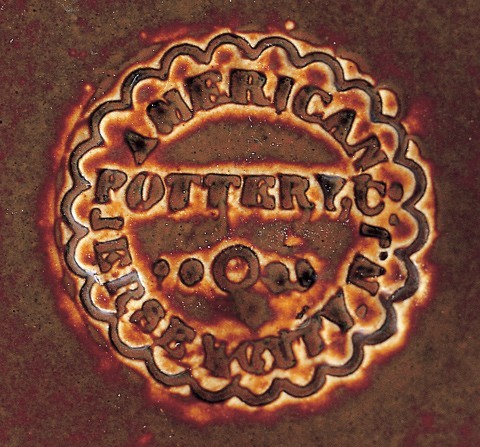
Detail of the mark on the bottom of the pitcher illustrated in fig. 13.
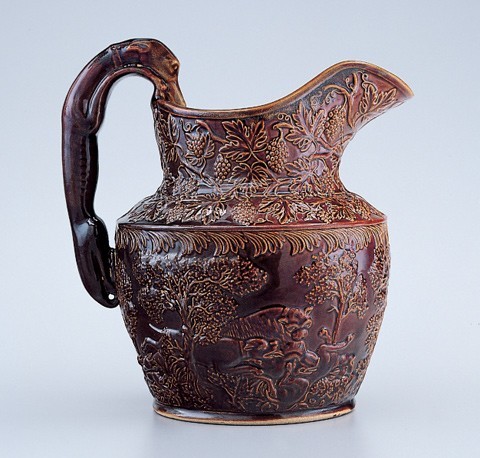
Hound-handle pitcher, American Pottery Company, Jersey City, New Jersey, 1840–1850. Rockingham glazed stoneware. H. 8 1/2". This molded pitcher has a reddish brown glaze outside and a putty colored glaze inside. A vine with leaves, tendrils, and grape clusters is on its neck and shoulder.
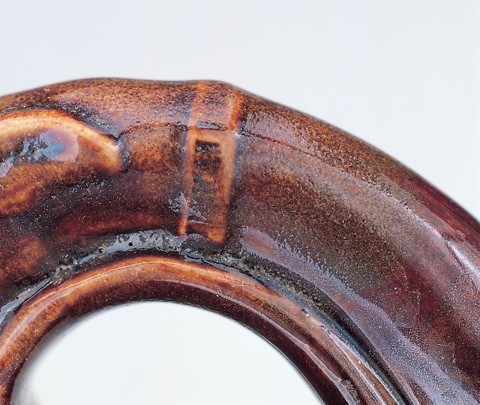
Detail of the “AMERICAN POTTERY” mark on the collar band of hound-handle pitcher illustrated in fig. 15.

Pitcher, attributed to the American Pottery Co., Jersey City, New Jersey, ca. 1845. Rockingham glazed earthenware. H. 9 1/4". This molded pitcher is decorated with an elaborate design featuring gothic architecture and eight apostles. This example is unmarked although a similar pitcher with the American Pottery Co. mark is in the Clement Collection, Brooklyn Museum of Art.
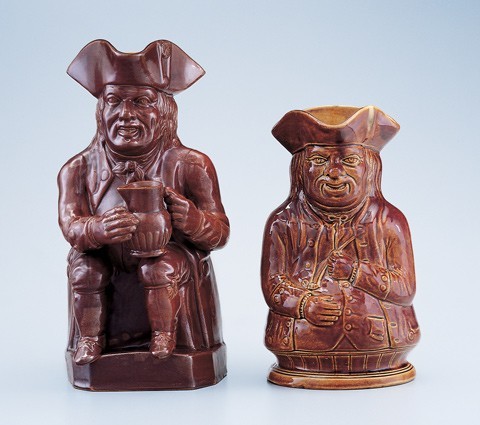
Toby Philpott pitchers. Left: attributed to the Salamander Works, New York City or Woodbridge, New Jersey, 1837–1850s. Rockingham glazed stoneware. H. 13". This example has a reddish brown glaze, double dipped on its upper body, and a putty colored glaze inside. This form probably represents pattern J on the Salamander Works’ 1837 price list. Right: attributed to the American Pottery Company, Jersey City, New Jersey, 1840. Rockingham glazed stoneware. H. 9". This pitcher has a rustic branch handle and a reddish brown, putty colored glaze inside.
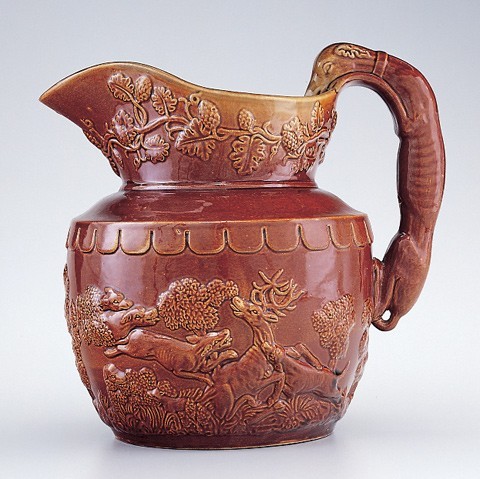
Hound-handle pitcher, attributed to Salamander Works, New York City or Woodbridge, New Jersey, 1837–1850s. Rockingham glazed stoneware. H. 11". A hunt scene of hounds attacking a stag is on one side and a boar being attacked by mastiffs is on the other. The pitcher has a leafy hop vine with flowers around the neck and a scalloped design around the shoulder.
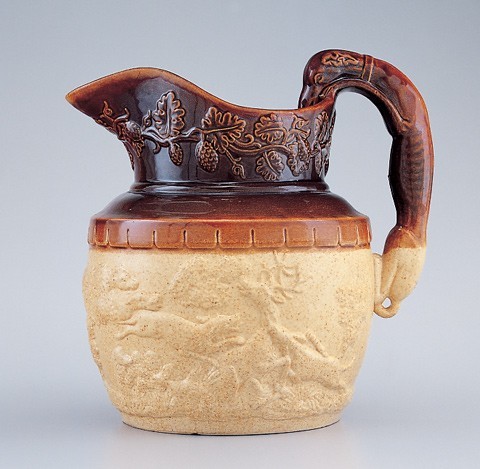
Hound-handle pitcher, Salamander Works, New York City or Woodbridge, New Jersey, 1837–1850s. Rockingham glazed stoneware. H. 10". A hunt scene of hounds attacking a stag is on one side and a boar being attacked by mastiffs is on the other. The lower half of the pitcher is not glazed, and the interior is putty colored. The neck has a leafy hop vine with flowers, and the shoulder has a square scalloped fringe. The base is embossed “B2.” This pitcher is called the “Hound Pattern” on the Salamander Works’ 1837 price list.

Pitcher, Salamander Works, New York City or Woodbridge, New Jersey, 1837–1850s. Rockingham glazed stoneware. H. 11 1/2". This example is a reddish brown color with a putty colored glaze inside; an oak leafed branch with acorns is around its neck, a lotus leaf design on its shoulder, and its body surface is covered with elaborate parallel rhomboids surrounded by a delicate dot-like design simulating a pineapple. It has a branch handle and is embossed N1 on the base.

Covered pitcher, Swan Hill Pottery, Edward Hanks and Charles Fish, South Amboy, New Jersey, 1850–1852. Yellow ware. H. 11 7/8". This example has a strainer spout and an elaborate bifid branch handle with a branch finial on the lid.
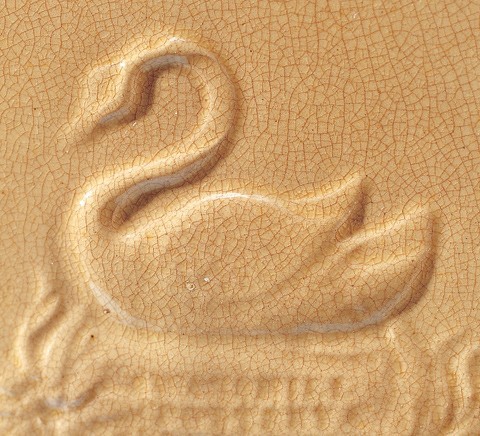
Detail of the mark on the base of the yellow ware pitcher illustrated in fig. 22. It is impressed “SWAN HILL/POTTERY/SOUTH AMBOY.”
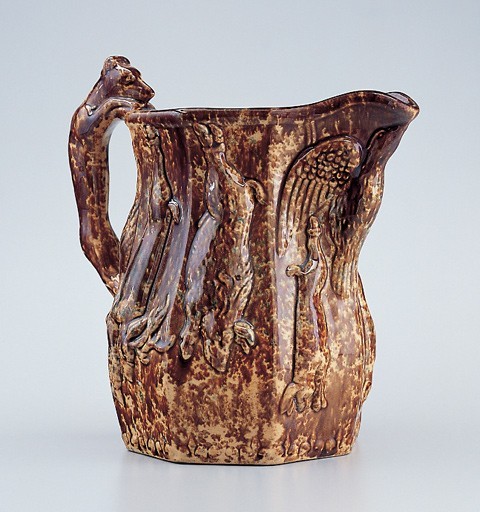
Hound-handle pitcher, possibly East Liverpool, Ohio, mid-nineteenth century. Rockingham glazed earthenware. H. 9 3/4". This eight sided pitcher has a molded eagle beneath its spout and is colored with a speckled blue flint glaze.
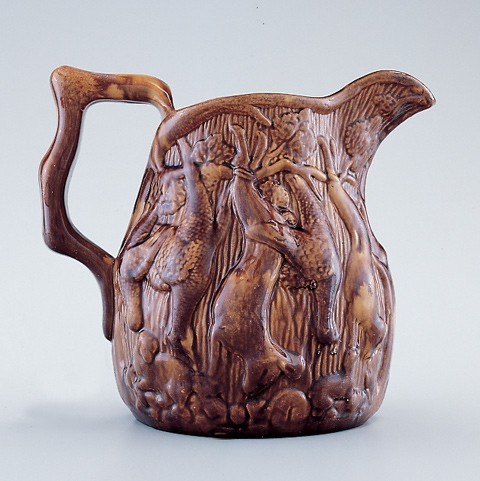
Pitcher, American, mid-nineteenth century. Rockingham glazed earthenware. H. 10". This molded pitcher has a hanging game scene and a branch shaped handle. Three stilt marks in a triangular pattern are on the base.

Presentation pitcher, attributed to John L. Rue and Company, 1870. Rockingham glazed earthenware. H. 9". The pitcher has a branch-shaped handle and a flint enamel glazed frog inside on the bottom. The name “D. REGAN” in raised white glazed letters is on the front with “Daniel Regan” and “August 3, 1870” incised on the base.
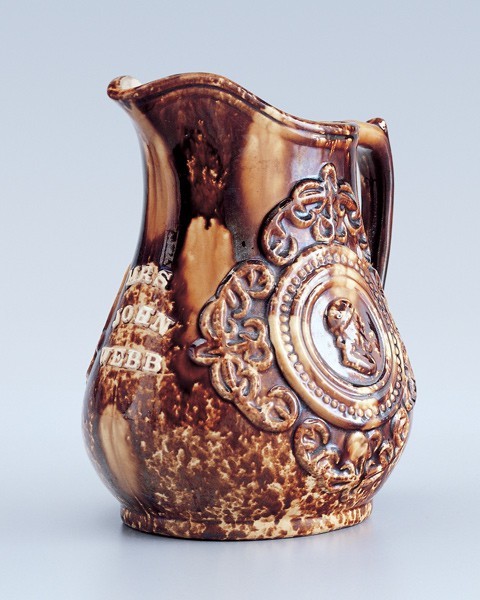
Presentation pitcher, probably South Amboy, New Jersey, 1860–1870. Rockingham glazed earthenware. H. 10". This pitcher may have been made by John L. Rue and Company, the Swan Hill Pottery, or a later firm copying their work. It has an elaborate filigree-like design around a circular medallion with a bearded man’s head. On the front, in white letters, is the name “MRS JOHN WEBB.” The inside has a white glaze and a molded Rockingham glazed frog on the bottom.
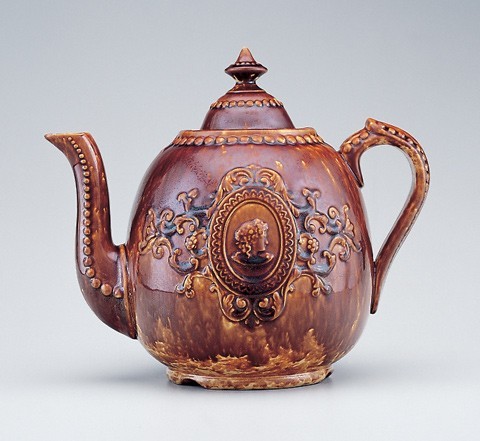
Teapot, attributed to John E. Jeffords and Company, Philadelphia, 1868–ca. 1876 and possibly later. Rockingham glazed earthenware. H. 9 3/4". A medallion of a woman’s head is on both sides.

Pitcher attributed to John E. Jeffords and Company, Philadelphia, 1868–ca. 1876 and possibly later. Rockingham glazed earthenware. H. 8". A medallion of a woman’s head is on both sides.

Pitcher, American, mid- nineteenth century. Rockingham glazed earthenware. H. 11 1/8".
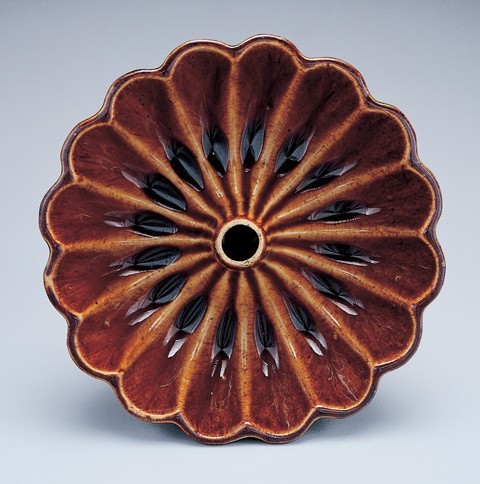
Cake mold, American, mid- nineteenth century. Rockingham glazed earthenware. D. 10".
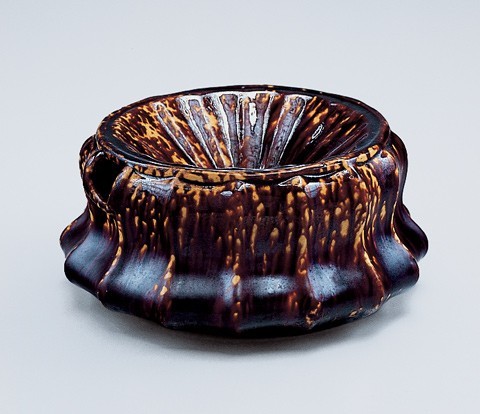
Spittoon, Harker, Taylor & Company, East Liverpool, Ohio, ca. 1852. Rockingham glazed earthenware. D. 8 1/2". Impressed mark on base: “ETRURIA WORKS/EAST LIVERPOOL” in circle with “1852” in center.
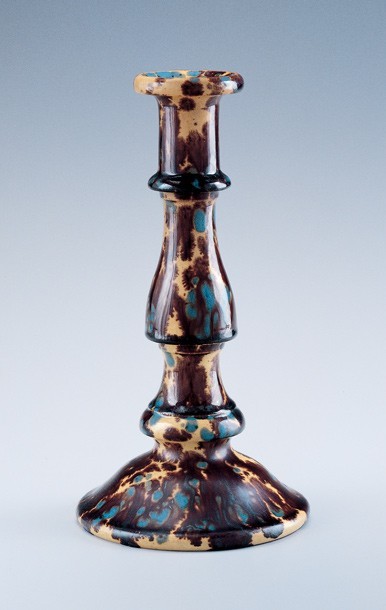
Candlestick, Lyman, Fenton & Co. / United States Pottery Company, Bennington, Vermont, 1849–1858. Rockingham glazed earthenware. H. 9 3/8". Flint enamel was added to the glaze.
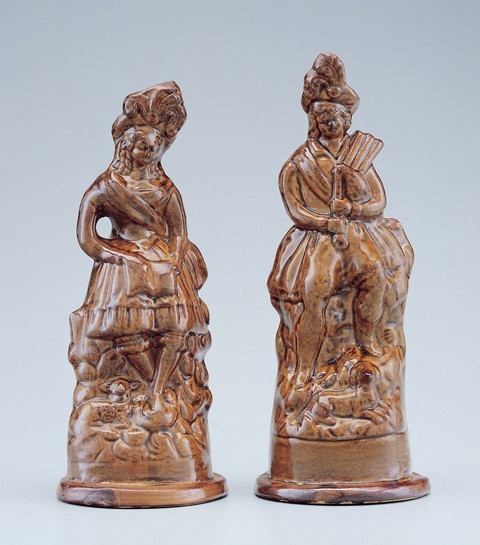
Figures probably by W. H. Farrar, Geddes (Syracuse), New York, ca. 1840–1857, or made in Lyons, New York, by Nathan Clark or Thompson Harrington in the 1850s. Rockingham glazed molded earthenware H. 9 7/8" and 10 1/4". These unmarked figures have a quarter inch central hole in the base.
